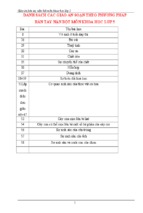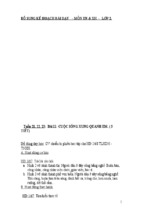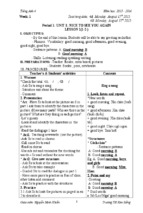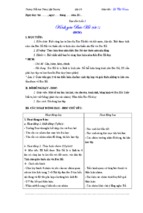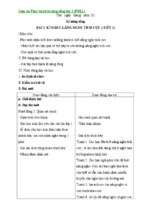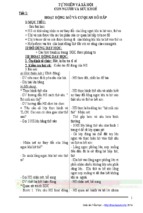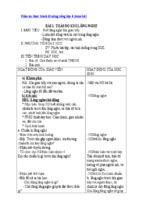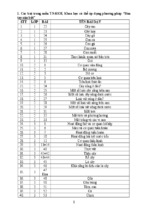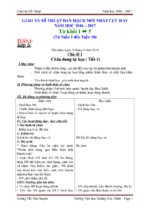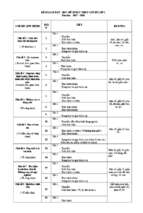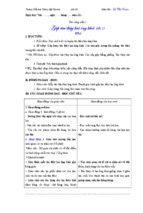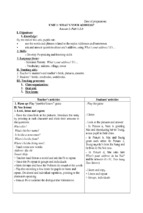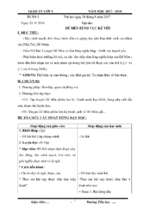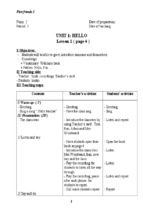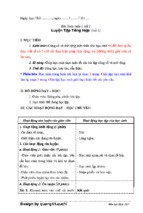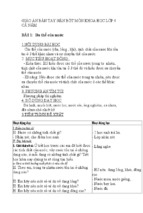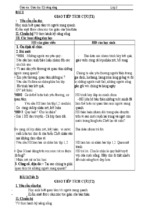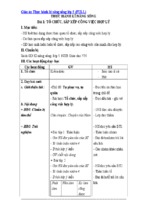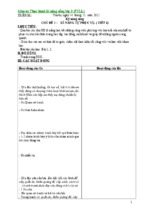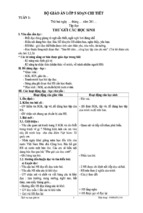Date of planning: 23/8/2014
Date of teaching: 3A:26/8
Week 1st
3B:25/8
3C:27/8
3D:26/8
P.1 - UNIT 1: Hello
Lesson 1: Part 1 - 2 - 3
I. Objective
By the end of the lesson, pupils will be able to:
- Use the words and phrases related to the topic Introduction.
- Greet others and introduce themselves, using: Hello/Hi. I’m + (name).
And Nice to meet you. Nice to meet you too.
- Develop pupils speaking and listening skills.
II. Teaching aids:
Books, notebooks, recordings.
III. Teaching process:
1.Class organization:
2. Warm up:
Teacher and pupils introduce themselves.
3. New lesson:
1. Look, listen and repeat.
- Ask pupils to open their Student’s Book on Page 6 and look at the picture
of the class. Help them to identify the teacher (Miss Hien) and the pupils.
Tell pupils that they are going to look at the dialogue in their Student’s
Book, listen to the recording and repeat the dialogue between Miss Hien and
the pupils.
- Play the recording through for pupils to listen to the dialogue.
- Play the recording again, pausing after each line for pupils to repeat.
Repeat the step when necessary.
- Divide the class into two groups. Ask one group to repeat Miss Hien’s part
and the other the pupils’ part.
2. Point and say
- Ask pupils to look at Pictures on Page 6. Tell them to identify the people in
each picture, practice saying: Hello/ Hi. I’m ……..
- Write the whole sentences on the board. Ps repeat the sentences a few
times
- Ask pupils to work in pairs, one pupil says the greetings and the other the
responses. Repeat the step but this time ask pupils to swap their roles.
- Select some pairs of pupils to demonstrate the task in front of the class.
Monitor the activity. Check pupils’ pronunciation and offer help when
necessary.
If having time. Have pupils to practice greetings and response freely in pairs.
- Pairs role play in front of the class, the others listen and remark, T corrects
mistakes.
3. Let’s talk
- Ask pupils to practice more with their friends. Point to each character
eliciting the name. Ask Ps to guess what the children say. Fill the gap and
write the sentences on the board. Gets Ps to repeat them a few times.
- Get Ps to work in pairs or groups of three to interact.
- Call a few pairs to act out the greetings and responses in front of the class.
Correct the pronunciation, if necessary.
Note: Tell Ps to say: Hello to their teachers or adults and Hi to their peers.
4. Consolidation
- T remarks the lesson.
======================================================
=
Date of planning: 23/8/2014
Date of teaching: 3A:26/8
3B:25/8
3C:27/8
3D:26/8
P.2 - UNIT 1: Hello
Lesson 1: Part 4-5-6
I. Objective
By the end of the lesson, pupils will be able to:
- Use the words and phrases related to the topic Introduction.
- Greet others and introduce themselves, using: Hello/Hi. I’m + (name).
And Nice to meet you. Nice to meet you too.
- Greet someone formally.
- Listen to the recording about the greetings and responses and tick the
pictures they hear.
- Develop pupils speaking, writing and listening skills.
II. Teaching aids.
Books, notebooks, recordings.
III. Teaching process
1.Class organization
2. Warm-up:
- Have some pairs greet and respond in front of the class.
3. New lesson
4. Listen and tick.
- Ask pupils to look at Pictures: 1. a, b; 2. a, b on Page 7. Help them to
identify the people in each picture ( Picture 1. a: Nam and Mai; Picture 1b:
Nam and Quan; Picture 2a: Miss Hien and class; Picture 2b: Miss Hien and
Nam).
- Tell the class that they are going to listen and tick the correct boxes under
the pictures.
- Play the recording through for pupils to listen and tick the correct answers.
1. Nam: Hello. I’m Nam.
Quan: Hello, Nam. I’m Quan. Nice to meet you.
2. Miss Hien: Hello. I’m Miss Hien.
Class: Hello, Miss Hien. Nice to meet you.
- Play the recording once more for pupils to check their answers.
- Ask pupils to exchange their answers before reporting them to class.
- Read out the answers to the class. Provide the explanation when necessary.
Answers: 1. b
2. a
Follow up: Ask pupils to work in pairs to practice greetings and responding
to each part of the day.
5. Let’s write.
Ask Ps to fill the gaps with I’m/ Hello. Give Ps a few seconds to read the
texts in silence. Check comprehension and give feedback. Elicit the words
filling the gaps. Remind Ps to write the initial letter of the word at the
beginning of each sentence in capital letters.
- Allow Ps time to do the task. Go around to offer help, if necessary.
- Get Ps to swap and check their answers before writing the correct answers
on the board for Ps to copy down into their notebooks.
- Call a few open pairs to read the exchanges aloud.
6. Let’s sing.
- Tell Ps that they are going to sing the Hello song. Teach the song.
- Read the lyrics and check comprehension. Play the recording or singing the
song all the way through.
- have Ps do choral and individual repetition of the song line after line.
When they are familiar with the tune, ask a group of three to the front of the
class. Each of them sings Hello. I’m + name twice. Then the class sings
Nice to meet you twice, waving their hands to the three singers.
- Have the class sing the song again to reinforce learning.
4. Consolidation
- Teacher remarks the lesson.
Date of planning: 23/8/2014
Date of teaching: 3A:28/8
3B:8 /8
3C:28/8
3D:27/8
P.3 - UNIT 1: Hello
Lesson 2: Part 1 – 2 - 3
I. Objective
By the end of the lesson, pupils will be able to:
- Use the words and phrases related to the topic Introduction.
- Greet others and introduce themselves, using: Hello/Hi. I’m + (name).
And Nice to meet you. Nice to meet you too.
- Greet and respond to greetings, using: How are you? I’m fine, thanks.
And you?
- Develop pupils speaking and listening skills.
II. Teaching aids.
Books, notebooks, recordings, flash cards
III. Teaching process
1.Class organization
2. Warm up: Ask pupils to say their names and say good bye.
Get class sing the Hello song
3. New lesson
1. Look, Listen and repeat
- Ask pupils to open their Student’s Book on Page 8. Tell the class that they
are going to practice saying and responding to Hello/Hi, + name and How
are you? Check understanding.
- Have Ps repeat the language a few times. Repeat the procedure with the
second picture.
- Do choral and individual repetition, pointing to the characters speaking.
- Play the recording for Ps to listen and say along.
2. Point and say.
- Tell Ps that they are going to practice saying: How are you? Fine, thanks/
thank you. And you?
-Draw Ps’ attention to the pictures. Point to each character and elicit his/her
name. Point to the first pic and elicit the words to fill the gaps. Put the
sentences on the board.
- Divide the class into two groups to do choral and individual repetition.
Repeat the procedure with the second pic.
Get Ps to work in pairs. Check as a class.
3. Let’s talk.
- Tell the class that they are going to practice more with their friends, using
their own names.
-Draw Ps’ attention to the pictures. Point to each character and elicit his/her
name. Point to the first pic and elicit the words to fill the gaps. Put the
sentences on the board and do choral and individual repetition.
- Get Ps work in pairs. Go around to offer help, if necessary.
- Call a few pairs to act out the dialogue in front of the class.
4. Consolidation
- T remarks the lesson.
======================================================
=
Date of planning: 23/8/2014
Date of teaching: 3A:28/8
3B:8 /8
3C:28/8
3D:27/8
P.4 - UNIT 1 : Hello
Lesson 2: Part 4-5-6
I. Objective
By the end of the lesson, pupils will be able to:
- Use the words and phrases related to the topic Introduction.
- Greet others and introduce themselves, using: Hello/Hi. I’m + (name).
And Nice to meet you. Nice to meet you too.
- Greet and respond to greetings, using: How are you? I’m fine, thanks.
And you?
- Say Goodbye, using Goodbye/ Bye
- Develop pupils speaking, listening and writing skills.
II. Teaching aids.
Books, notebooks, recordings
III. Teaching process
1.Class organization
2. New lesson
- Have Ps play the Slap the board game, using the names of the characters:
Miss Hien, Mai, Nam, Quan, Hoa, Phong
3. New lesson
4. Listen and number.
- Ask pupils to look at pictures on Page 8. Tell them that they are going to
listen to four dialogues and number the correct pictures.
- Play the recording through for pupils to listen.
1. A: Hello. I’m Miss Hien.
2. A: How are you, Miss Hien?
B: Hello Miss Hien. Nice to meet you.
B: I’m fine, thanks. And you?
A: I’m fine, thank you.
3. A: Goodbye, class.
4. A: Bye, Mai.
B: Goodbye, Miss Hien.
B: Bye, Nam.
Answers: 1. d
2. c
3.b
4. a
5. Read and complete.
- Ask pupils to open their Student’s Book on Page 9. Tell pupils that they are
going to read and fill the gaps with the appropriate words. Give Ps a few
seconds to read the text in silence. Check comprehension and give feedback.
- Give Ps time to do the task and go around to offer help, if necessary.. Get
Ps to work in pairs.
- Get Ps to swap and check their answers before checking as a class.
- Divide the class into two groups and get them to read aloud each
character’s line respectively.
Key: 1. Goodbye
2. Bye
3. Fine
4. thank you
6. Let’s write.
- Tell Ps that they are going to read and fill the gaps. Draw Ps’ attention to
the pic and text. Give Ps a few seconds to read the text in silence. Elicit the
words filling the gaps.
- Allow Ps time to do the task. Go around to offer help, if necessary.
- Get Ps to swap and check their answers before writing the correct answers
on the board for Ps to copy down into their notebooks.
- Call a few open pairs to act out the dialogue.
4. Consolidation
- Teacher remarks the lesson.
======================================================
=
EXTRA WEEK
Date of planning:29/8/2014
Date of teaching: 3A:4/9
3B:4/9
3C:4/9
3D:3/9
REVIEW
I.Objectives: By the end of lesson Ss will be able to:Review the vocab and
sentence patterns in unit 1.
● Sentence patterns: Hi/ Hello. I am+ name.
How are you? I’m fine, thank you.
● Vocabularies: Hi, Hello, fine, how, thanks…
II. Teaching aids.
Books, notebooks, recordings
III. Teaching process
1.Class organization
2.Checking old lesson
Pupils sing the song Hello.
3. New lesson
A. Warm Up: Play game: “ Physical line-up”
B. New Lesson:
1. Lesson 1: Greeting and self introducing.
Sentences patterns : Hello / Hi. I’m Nam.
- Listen and take note
- Practice by work in pairs with sentences patterns. Hello/ Hi, I’m Mai…
2. Lesson 2: Greeting and responding to the greeting.
Making and responding to introductions
Saying goodbye
- Listen and take note
- Practice by work in pairs with sentences patterns. How are you?
I’m fine, thank you.
C. Home link:
- Consolidate the lesson .
- Give remarks
- Ss learn by heart New words and sentences pattern.
Date of planning:29/8/2014
Date of teaching: 3A:4/9
3B:4/9
3C:4/9
3D:3/9
REVIEW
I.Objectives: By the end of lesson Ss will be able to:Review the vocab and
sentence patterns in unit 1.
● Sentence patterns: Hi/ Hello. I am+ name.
How are you? I’m fine, thank you.
● Vocabularies: Hi, Hello, fine, how, thanks…
II. Teaching aids.
Books, notebooks, recordings
III. Teaching process
1.Class organization
2.Checking old lesson
Pupils sing the song Hello
3. New lesson
Ex1. Odd one out
Guide the SS how to do this exercise
1. hi
hello
bye
2. Tom Tony
fine
3. I
are
you
4. am
are
thank
Ex2. Listen and write
1. ………… I’m Mai.
2. ………are you?
3. I’m ………, thanks.
4. Hello. …………… Miss Hien.
Ex3. Reorder the word.
1. I / hello. / Mai / am /
2. you / nice / meet / to
3. Hi, / I / Nam / Mai / am /
4. Miss / Hello. / I / Hien / am /
5. Miss / Hello, / nice / you / Hien / meet/ to
6. are / how/ you?
7. am / thank / I/ fine /you
8. fine/ I/ thanks/ And you? / am
- Remark and correct the excersices.
Week 2nd
Date of planning: 4/9/2014
Date of teaching: 3A:9/9
3B:8/9
3C:10/9
3D:9/9
P.5 - UNIT 1: Hello
Lesson 3: Part 1-2-3
I. Objective
By the end of the lesson, pupils will be able to:
- Use the words and phrases related to the topic Introduction.
- Greet others and introduce themselves, using: Hello/Hi. I’m + (name).
And Nice to meet you. Nice to meet you too.
- Greet and respond to greetings, using: How are you? I’m fine, thanks.
And you?
- Say Goodbye, using Goodbye/ Bye
- Pronounce the sounds of the letters: b and h in the words bye and
hello respectively.
- Develop pupils speaking, listening and writing skills.
II. Teaching aids.
Books, notebooks, recordings
III. Teaching process
1.Class organization
2. Warm up: Revising Hi/ Hello. How are you? I’m fine, thanks/ thank you.
And you? Get Ps to play game Physical line-up
3. New lesson
1. Listen and repeat.
- Ask pupils to open the Student’s Book on Page 10. Tell them that they are
going to listen to practice saying the letters, words and sentences in the
book.
- Put the phonics letters: b and h on the boardand say them a few times. Ask
Ps to repeat after you.
- Prompt Ps to say the words and sentences, paying attention to the target
phonics letters.
- Do choral repetition of the words and sentences until Ps feel confident.
2. Listen and write.
- Tell Ps that they are going to do a dictation. Give Ps a few seconds to read
the text in silence before starting the dictation.
- Have Ps swap and check their answers before writing the correct answers
on the board for Ps to copy down into their notebooks.
- Get Ps to work in pairs and practice saying the sentences.
Key: 1. Bye
2. Hello.
3. Let’s chant.
- Tell Ps that they are going to say the Hello chant. Read the chant and check
comprehension.
- Play the recording a few times for Ps to do choral and individual repetition.
Show Ps how to chant and do the actions. Call two groups of four to give a
demonstration.
- Get groups of Ps to sit face to face and practice chanting and doing the
actions. Go around to offer help, if necessary
- Call 2 groups to chant and do the action. The rest of the class claps along to
rhythm of the chant.
4. Consolidation.
- T Remarks the lesson.
Date of planning: 4/9/2014
Date of teaching: 3A:9/9
3B:8/9
3C:10/9
3D:9/9
P.6 - UNIT 1: Hello
Lesson 3: Part 4-5-6
I. Objective
By the end of the lesson, pupils will be able to:
- Use the words and phrases related to the topic Introduction.
- Greet others and introduce themselves, using: Hello/Hi. I’m + (name).
And Nice to meet you. Nice to meet you too.
- Greet and respond to greetings, using: How are you? I’m fine, thanks.
And you?
- Say Goodbye, using Goodbye/ Bye
- Develop pupils reading, writing, speaking and listening skills.
II. Teaching aids.
Books, notebooks, recordings.
III. Teaching process
1.Class organization
2. Warm-up:
- Have some pairs of pupils ask and answer the question: How are you?
A: How are you?
B: I’m fine, thank you. And you?
A: I’m fine, thanks.
- Have the class say the Hello chant.
3. New lesson
3. Read and match.
- Ask pupils to open their Student’s Book on Page 11. Tell them that they
are going to read all the sentences on the left and pair them with those on the
right by drawing a line between them. Give a few seconds for Ps to read the
text in silence. Use the first pair of sentences as an example to make the task
clear. Get Ps to work in pairs.
- Give Ps time to do the matching. Go around to offer help, if necessary.
- Get Ps to swap and correct their answers before checking as a class.
- Do choral and individual repetition of the sentences.
Key: 2a 3b 4c
5. Read and write.
- Tell Ps that they are going to read and fill the gaps with the appropriate
words. Give Ps a few seconds to read the texts in silence. Check
comprehension and give feedback.
- Allow Ps time to do the task. Go around to offer help, if necessary.
- Get Ps to swap and check their answers before writing the correct answers
on the board for Ps to copy down into their notebooks.
- Do choral and individual repetition of the sentences.
Key: 1. Hello/Hi
2. I’m
3. Nice
4. How
5. Fine/I’m fine
6. Project.
- Tell Ps that they are going to make their name cards and present them to
their class. Check understanding. Get Ps to prepare necessary school things
to carry out the project ( paper, pens, coloured pencils, scissor, glues…)
- Give Ps time to do the project in the class. Get Ps to work in groups. Go
around to offer help, if necessary.
- Call several Ps to the front of the class to present their cards, using their
name cards and saying Hello. I’m …
- Have Ps stick their cards on the walls of the classroom.
Have the class sing the Hello song and the Hello chant to end the class.
4. Consolidation.
- Teacher remarks the lesson.
======================================================
=
Date of planning: 4/9/2014
Date of teaching: 3A:11/9
3B:11/9
3C:11/9
3D:10/9
P.7 - Unit 2: What’s your name?
Lesson 1: Part 1-2-3
I.Objective
By the end of the lesson, pupils will be able to:
- Ask and answer questions about one’s name.
.- Develop pupils, speaking and listening skills.
- The vocabulary: What, name, my, your, is
- The structure:
- What is your name?
- My name’s + name.
II. Teaching aids.
Books, notebooks, recordings, flash cards
III. Teaching process
1.Class organization
2. Warm-up:
- Have some pairs of pupils ask and answer the question
A: How are you?
B: I’m fine, thank you. And you?
A: I’m fine, thanks.
- Have the class say the Hello chant.
3. New lesson
1. Look, listen and repeat.
- Ask ss look at the picture and listen to the dialogue in their books.
- Tell them that they are going to practise introducing themselves and
responding to the introduction( vietnamese).
- Point to the P1 and Ask ps look at the text in speech bubbles.Use a poster
or two character puppets to present the situation.
- Explain the meaning of the language practised.
Name: tên
What: cái gì
Is: là
My: của tôi
Your: của bạn
Note: Name’s = name is
What’s= What is
- Play the recording all the way through for pupils to listen, and point to the
appropriate line in their books.
- Play the recording again for pupils to repeat the lines in the speech bubbles.
Repeat the step a few times.
- Practice with ps.
- Devide the class into 2 groups. Askps practice in pairs.
- Go round and check ps can repeat and understand the dialogue.
2. Look and say
- Have pupils look at Pictures. Ask them to identify the characters in the
pictures. Use flashcards to teach the question and answer in the speech
bubbles. Have pupils repeat the phrases a few times.
Peter: What’s your name?
Phong: My name’s Phong.
- Tell ps that they are going to practise asking and answering questions
about one’s name
- Point to each character in the picture and elicit his/her name and the words
to fill the gaps.
- Write the whole sentences on the board.
- Have ps repeat the sentences a few times.
- Repeat the procedure with the second picture.
- Ask ps work in pairs.
- Call some pairs practice in front of the class.
- Check ss’ mistake when necessary.
- Model: Call on a pair and ask them to pretend to be the characters to act
out the exchange. Repeat the step but this time have the pair swap their
parts. Call on one more pair to act out as Nga and Phong, following the same
way with Nam and Mai. Have the class repeat all the phrases in this section.
- Pairwork. Pupils practise in pairs. Monitor the activity, check the
pronunciation (stress, assimilation of sounds and intonation), and offer help
when necessary.
- Call on some pairs to perform the task at the front of the class. The rest of
the class observe and give comments if possible.
- Make a few questions to check pupils’ comprehension of the language.
- Have the whole class repeat all the phrases in chorus to reinforce their
pronunciation.
3: Let’s talk.
- Tell ps that they are going to practise more with their friends.
- Point to each character eliciting the name.
- Ask ps to guess what the children say.
- Fill the graps and write the sentences on the board.
- Get ps to repeat the sentences a few times.
- Get ps work in pair of three to interact.
- Call a few pairs practise in front of the class.
- Check ss’ pronounciation.
4. Consolidation
- T remarks the lesson.
Date of planning: 4/9/2014
Date of teaching: 3A:11/9
3B:11/9
3C:11/9
3D:10/9
P.8 - Unit 2: What’s your name?
Lesson 1: Part 4- 5-6
I.Objective
By the end of the lesson, pupils will be able to:
- Ask and answer questions about one’s name.
.- Develop pupils, speaking and listening skills.
- The structure:
- What is your name?
- My name’s + name.
- Pupils know how to sing the alphabet song.
II. Teaching aids.
Books, notebooks, recordings, flash cards
III. Teaching process
1.Class organization
2. Warm-up:
- Have some pairs of pupils aks and answer the question:
A: What is your name?
B: My name is Nam. What is your name?
A: My name is Mai.
3. New lesson
4: Listen and tick
- Ask Ss to look at the pictures: What are they doing?
- Tell ps that they are going to listen and tick the correct boxes under the
pictures.
- Draw their attention to the pictures.
- Elicit the name of the characters. Have ps repeat them once or twice.
- Play the recording through for Ss to listen.
- Play the recording again for Ss to listen and tick the correct answers.
- Ask Ss to exchange their answers with their partners before reporting them
to the class.
- Correct, remark.
- Play the recording again to Ss repeat follow
1. Linh: I’m Linh. What’s your name?
Peter: Hello, Linh. My name’s Peter. Nice to meet you.
2. Nam: Hi. My name’s Nam. What’s your name?
Linda: Hello, Nam. I’m Linda. Nice to meet you.
5: Look and write
- Ask Ss to look at the pictures.
- Tell Ss what they are going to fill the grap folowing the pictures.
- Ask Ss to read individually silently and complete the dialogues.
- Check comprehension and give feedback.
- Elicit the words filling the graps. Remind ps to write the intial letter of the
word at the beginning of each sentences in capital lettters.
- Allow ps time to do the task. Go around to offer help if necessary.
- Ask Ss to read their answers aloud to the class.
- Correct, remark and give keys.
1. A: What’s your name?
B: My name’s Peter .
2. A: I’m Mai.
What’s your name?
B: My name’s Linda.
- Have the whole class read each line of the dialogues chorally to reinforce
their pronunciation.
6: Let’s sing
- Ask Ss to open their Student’s book on page 13. Stick the large- sized sheet
of paper with the sing on page 7 on the board. Tell them that they are going
to sing The alphabet song.
- Play the recording all the way through for Ss to get familiarized with the
pronunciation, the stress, the rhythm and the intonation of the song.
- Play the recording again, pausing after each line for Ss to repeat.
- Play the recording once more for Ss to repeat the whole song.
- Call on some Ss to sing the song in front of the class. The rest of the class
clap their hands at rhythms.- Sing the song in the prepared clip.
AB C D E F G
H I J K L M N O P
Q R S T U V
W X Y Z
Now I know my ABCs.
Next time will you sing with me?
4. Consolidation
- T remarks the lesson.
======================================================
=
WEEK 3rd
Date of planning: 10/9/2014
Date of teaching: 3A:16/9
3B:15/9
3C:17/9
3D:16/9
P.9 - Unit 2: What’s your name?
Lesson 2: Part 1-2-3
I.Objective
By the end of the lesson, pupils will be able to:
- Ask and answer questions about one’s name.
.- Develop pupils, speaking and listening skills.
- The structure:
- What is your name?
- My name’s + name.
-Spell a name and ask how to spell a name, using How do you spell your
name?
II. Teaching aids.
Books, notebooks, recordings, flash cards
III. Teaching process
1.Class organization
2. Warm-up:
- Have some pairs of pupils aks and answer the question:
A: What is your name?
B: My name is Nam. What is your name?
A: My name is Mai.
3. New lesson
1. Look, listen and repeat:
- Ask pupils to open their Student’s Book on Page 14. Tell them that they
are going to spell names.
- Have Ps repeat the language a few times. Repeat the procedure with the
second picture.
- Explain how to spell one’s name .
- Have Ps practise spelling several names.
- Do choral and individual repetition, pointing to the characters speaking.
- Play the recording for Ps to listen and say along.
2. Point and say.
- Tell Ps that they are going to practice spelling names.
-Draw Ps’ attention to the picture. Point to each character and elicit his/her
name. Put the question and the anwser on the board.
- Have Ps repeat the language a few times. Repeat the procedure with the
second picture.
- Do choral and individual repetition of the letters in focus : L,I,N,D,A,Q,U,
P,E,R be fore having Ps drill the spelling.
- Divide the class into two groups to do choral and individual repetition.
Repeat the procedure with the second pic.
Get Ps to work in pairs. Check as a class.
3. Let’s talk.
- Tell the class that they are going to practice more with their friends, using
their own names.
-Draw Ps’ attention to the pictures. Point to each character and elicit his/her
name. Point to the first pic and elicit the words to fill the gaps. Put the
sentences on the board and have the class repeat the question and the
answers a few times.
- Get Ps work in pairs. Go around to offer help, if necessary.
- Call a few pairs to act out the dialogue in front of the class.
4. Consolidation
- T remarks the lesson.
======================================================
=
Date of planning: 10/9/2014
Date of teaching: 3A:16/9
3B:15/9
3C:17/9
3D:16/9
P.10 - Unit 2: What’s your name?
Lesson 2: Part 4-5-6
I.Objective
By the end of the lesson, pupils will be able to:
- Ask and answer questions about one’s name.
.- Develop pupils, speaking and listening skills.
- The structure:
- What is your name?
- My name’s + name.
-Spell a name and ask how to spell a name, using How do you spell your
name?
II. Teaching aids.
Books, notebooks, recordings, flash cards
III. Teaching process
1.Class organization
2. Warm-up:
- Have some pairs of pupils aks and answer the question:
A: What is your name?
B: My name is Nam.
A: How do you spell your name?
B: N-A-M
3. New lesson
4. Listen and number.
- Ask pupils to look at pictures on Page 8. Tell them that they are going to
listen to four dialogues and number the correct pictures.
- Play the recording through for pupils to listen.
1. A: My name’s Peter.
2. A: My name’s Linda. What’s your
name?
B: Hello , Peter. My name’s Mai. B: HI, Linda. My name’s Quan.
3. A: How do you spell your name?
B: L-I-N-D-A
4. A: How do you spell your name?
B: P-E-T-E-R
Answers: 1. c
2. b
3.d
4. a
5. Read and match.
- Ask pupils to open their Student’s Book on Page 14. Tell them that they
are going to read all the sentences on the left and pair them with the picture
on the right by drawing a line between them. Give a few seconds for Ps to
read the text in silence. Use the first pair of sentences as an example to make
the task clear. Get Ps to work in pairs.
- Give Ps time to do the matching. Go around to offer help, if necessary.
- Get Ps to swap and correct their answers before checking as a class.
- Divide the class into two groups and get them to read aloud.
Key: 1c 2b
3a
6. Let’s write.
- Tell Ps that they are going to read and fill the gaps. Draw Ps’ attention to
the pic and text. Give Ps a few seconds to read the text in silence. Tell Ps to
give names to the new characters in the picture.
- Allow Ps time to do the task. Go around to offer help, if necessary.
- Get Ps to swap and check their answers before writing the correct answers
on the board for Ps to copy down into their notebooks.
- Call a few open pairs to act out the dialogue.
4. Consolidation
- Teacher remarks the lesson.
======================================================
=
Date of planning: 10/9/2014
Date of teaching: 3A:18/9
3B: 18/9
3C: 18/9
3D:17/9
P.11 - Unit 2: What’s your name?
Lesson 3: Part 1-2-3
I.Objective
By the end of the lesson, pupils will be able to:
- Ask and answer questions about one’s name.
.- Develop pupils, speaking and listening skills.
- The structure:
- What is your name?
- My name’s + name.
-Spell a name and ask how to spell a name, using How do you spell your
name?
- Pronounce the sounds of the of the letters m and p in the words Mai and
Peter.
II. Teaching aids.
Books, notebooks, recordings, flash cards
III. Teaching process
1.Class organization
2. Warm-up:
- Have some pairs of pupils aks and answer the question:
A: What is your name?
B: My name is Nam.
A: How do you spell your name?
B: N-A-M
3. New lesson
1. Listen and repeat.
- Ask pupils to open the Student’s Book on Page 16. Tell them that they are
going to listen to practice saying the letters, words and sentences in the
book.
- Put the phonics letters: m and p on the board and say them a few times.
Ask Ps to repeat after you.
- Prompt Ps to say the words and sentences, paying attention to the target
phonics letters.
- Do choral repetition of the words and sentences until Ps feel confident.
2. Listen and write.
- Tell Ps that they are going to do a dictation. Give Ps a few seconds to read
the text in silence before starting the dictation.
- Have Ps swap and check their answers before writing the correct answers
on the board for Ps to copy down into their notebooks.
- Get Ps to work in pairs and practice saying the sentences.
Key: 1. Peter 2. Mai.
3. Let’s chant.
- Tell Ps that they are going to say the What’s your name? chant. Read the
chant and check comprehension.
- Play the recording a few times for Ps to do choral and individual repetition.
Show Ps how to chant and do the actions. Call two groups of four to give a
demonstration.
- Get groups of Ps to sit face to face and practice chanting and doing the
actions. Go around to offer help, if necessary
- Call 2 groups to chant and do the action. The rest of the class claps along to
rhythm of the chant.
4. Consolidation
- Teacher remarks the lesson.
Date of planning: 10/9/2014
Date of teaching: 3A:18/9
3B: 18/9
3C: 18/9
3D:17/9
P.12 - Unit 2: What’s your name?
Lesson 3: Part 3-4-5
I.Objective
By the end of the lesson, pupils will be able to:
- Ask and answer questions about one’s name.
.- Develop pupils, speaking and listening skills.
- The structure:
- What is your name?
- My name’s + name.
-Spell a name and ask how to spell a name, using How do you spell your
name?
- Pronounce the sounds of the of the letters m and p in the words Mai and
Peter.
II. Teaching aids.
Books, notebooks, recordings, flash cards
III. Teaching process
1.Class organization
2. Warm-up:
- Have some pairs of pupils aks and answer the question:
A: What is your name?
B: My name is Nam.
A: How do you spell your name?
B: N-A-M
3. New lesson
4. Read and match.
- Ask pupils to open their Student’s Book on Page 17. Tell them that they
are going to read all the sentences on the left and pair them with those on the
right by drawing a line between them. Give a few seconds for Ps to read the
text in silence. Use the first pair of sentences as an example to make the task
clear. Get Ps to work in pairs.
- Give Ps time to do the matching. Go around to offer help, if necessary.
- Xem thêm -

